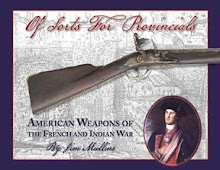One of the most prominent figures in the history of the 18th-century Virginia backcountry was
William Preston. During his lifetime, Preston wore many hats, serving as a Surveyor, a Soldier in two wars (both as a County Militia Officer as well as a
Ranging company officer during the French and Indian War) and as a Politician: fulfilling several roles in Virginia's Colonial Government. Preston became one of the most wealthy men in the region, amassing large amounts of land and experimenting in numerous revenue streams including land speculation, farming, the
slave trade and running a distillery. Preston lived at
"Greenfield", in Botetourt county during the 1760s and around 1773 began building a new home named
"Smithfield", in what would become Blacksburg in Montgomery County, Virginia near the site of
Draper's Meadow. The APVA's Historic Structures Report for the house can be found
here.
Smithfield is an (unusual for the area) 18th century timber frame building that would look more at home in Virginia's Tidewater region than in the Virginia backcountry, and as such was a powerful demonstration of his wealth and status when compared with the more common small log structures of his neighbors.
A 19th century copy of an 18th century drawing depicting Colonial era military Officers and Gentry carousing while an exhausted enslaved Servant stands by the wall in Charleston, South Carolina. " Mr. Peter Manigault and his friends drawn by one of them (Mr Roupell) about the year 1754 from which this copy is now made in August 1854 by his Great- Grand - Son Louis Manigault Charleston So.Ca." Gibbes Museum of Art Gift of Mr. Joseph E. Jenkins 1968.005.0001
Recent excavations at his Greenfield property uncovered portions of a mid 18th-century Earthenware
"clouded" or "Tortoiseshell" glazed plate as well as other artifacts including an
English trade gun buttplate. Preston's choice of ceramics for his table at Greenfield mirrored that many of his middling neighbors who utilized sturdy utilitarian pewter and stoneware tablewares; the lower sort perhaps treen.
"Tortoise Shell Cups and Saucers" Advertised alongside a variety of ready made slop clothing and common goods in the North Carolina Gazette (October, 1759, page 4)
A mid 18th century molded "clouded" plate similar to fragments excavated at Greenfield in 2016-2018 (Private collection).
The mottled and molded clouded or tortoiseshell glazed plates from Greenfield were evidently replaced by the more fashionable
"Creamware" style of molded earthenware in the upwardly mobile Preston family household by 1771. Preston was a very early adopter of this style in Virginia.
A ca. 1770-80 Creamware plate (Private collection).
Ann Smart Martin's Buying Into the World of Goods: Early Consumers in Backcountry Virginia mentions that:
"The earliest reference to Queen's ware- also known as cream-colored ware- in Virginia dates from 1768;
by the summer of 1771, a wealthy Tidewater planter had reported that Queen's ware had attained popularity among his peers. That [William] Preston also purchased "Queen's ware" on his 1771 trip [from Botetourt to Williamsburg] simultaneously illustrates his awareness of fashion and the absence of large sets in his own local market."
The earliest mention of "Queen's sets of cream coloured ware..." from the Virginia Gazette also references the universality of stone wares in the past and the novelty of the new cream wares. Virginia Gazette, Purdie and Dixon June 30, 1768 page 2.
Although he was one of the first to procure it in the backcountry; Preston wasn't the only man in Southwest Virginia who would own creamware. McCorkle's store in what is now Pulaski County, Virginia carried "Queen's china" around the eve of the Revolution, and scattered references are found in local estates and probate inventories, such as a 1773 court case involving the debts of a deceased blacksmith in Fincastle county and the 1776 will of Welsh immigrant and Chiswell's lead mine manager William Herbert.
Oval creamware platter from Fort Chiswell. Detail figure 48 from Excavations at Fort Chiswell (Funk/Hoffman/Holup/Revwer/Smith UVA Laboratory of Archaeology 1976).
At Fort Chiswell,
"Creamware was one of the more common ware types found at the site and was included in every structure...But
an earlier mottled glazed cream-colored ware (refined earthenware) known as "clouded" ware was produced in 1740. We have just one sherd of this type, located in Structure #2 in a sealed eighteenth century level..." (
Excavations at Fort Chiswell p61).
Creamware became immensely popular and despite being fairly new in the remote Virginia backcountry in 1774 English Potter Josiah Wedgewood foreshadowed that "I apprehend our customers will not much longer be content with Queen's Ware it being now render'd vulgar and common everywhere". Wedgewood's prediction would eventually prove truthful, and feather edge creamware fragments were recovered at Fort Boonesborough, among numerous other Revolutionary War era frontier sites.







